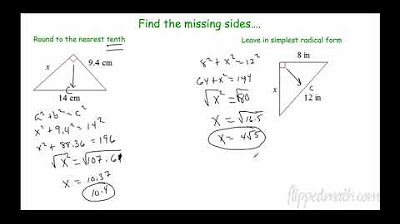Standard Form - Lesson 6.3
Summary
TLDRIn this lesson, Mr. Matt Bog teaches the standard form of linear equations, explaining how to convert between standard, point-slope, and slope-intercept forms. He introduces a shortcut for finding slope directly from standard form equations and provides clear steps for transforming equations into standard form. Through various examples, he demonstrates how to calculate the slope and use known points to find the constants in the equation. The lesson also covers handling fractions and negative coefficients, ensuring that students can easily convert and manipulate linear equations in different forms.
Takeaways
- 😀 Standard form of a linear equation is written as ax + by = c, where a and b are not both zero.
- 😀 Slope-intercept form (y = mx + b) and point-slope form (y - y1 = m(x - x1)) are other forms of linear equations.
- 😀 If an equation is in standard form, the slope can be found as the opposite of the number in front of x divided by the number in front of y.
- 😀 To convert fractions in standard form to integers, multiply the whole equation by the common denominator.
- 😀 Typically, in standard form, the coefficient of x (a) should be positive, though some textbooks may not emphasize this.
- 😀 To find the y-intercept in standard form, simply divide the constant (c) by the coefficient of y (b).
- 😀 When writing an equation with given slope and a point, substitute the values into the point-slope form and convert to standard form to solve for c.
- 😀 If the standard form equation results in a negative coefficient for x, the signs of the entire equation should be flipped for consistency.
- 😀 When solving for the y-intercept in slope-intercept form, use a given point and the slope to solve for b in the equation y = mx + b.
- 😀 In word problems, rate of change (e.g., gallons per minute) is typically the slope, and the initial value is used for the y-intercept.
- 😀 When rewriting equations in standard form, ensure fractions are eliminated, and maintain consistency in signs (positive leading coefficients).
Q & A
What is the general form of a linear equation in standard form?
-The general form of a linear equation in standard form is Ax + By = C, where A and B are not both zero.
What is the shortcut for finding the slope when an equation is in standard form?
-The slope is the opposite of the ratio of the coefficients of x and y. Specifically, if the equation is Ax + By = C, the slope is -A/B.
How do you find the y-intercept from an equation in standard form?
-The y-intercept can be found by setting x = 0 in the equation Ax + By = C, and solving for y.
What happens if the equation in standard form has fractions?
-If the equation contains fractions, multiply the entire equation by the common denominator to eliminate the fractions.
Why does the book prefer the coefficient of x in standard form to be positive?
-The book prefers the coefficient of x to be positive for consistency and to avoid negative leading coefficients, making the equation easier to work with.
What is the process to convert from point-slope form to standard form?
-To convert from point-slope form (y - y₁ = m(x - x₁)) to standard form (Ax + By = C), first expand the equation, then move terms involving x and y to one side and simplify.
How do you write an equation in standard form given a slope and a point on the line?
-Given the slope m and a point (x₁, y₁), the equation in standard form can be written by using the formula y - y₁ = m(x - x₁), then converting it to standard form by expanding and rearranging.
How do you convert from slope-intercept form to standard form?
-To convert from slope-intercept form (y = mx + b) to standard form, move the term involving x to the left-hand side and then simplify, ensuring both sides are integer values without fractions.
What is the significance of the negative sign when the slope is expressed in standard form?
-The negative sign is important because the slope in standard form is represented as -A/B, where A is the coefficient of x and B is the coefficient of y. This helps maintain the correct relationship between x and y in the equation.
How does the method of solving for C differ in point-slope and slope-intercept forms?
-In point-slope form, you solve for C by substituting a given point (x₁, y₁) into the equation. In slope-intercept form, you solve for the y-intercept b by substituting the slope and a point into the equation y = mx + b and solving for b.
Outlines

This section is available to paid users only. Please upgrade to access this part.
Upgrade NowMindmap

This section is available to paid users only. Please upgrade to access this part.
Upgrade NowKeywords

This section is available to paid users only. Please upgrade to access this part.
Upgrade NowHighlights

This section is available to paid users only. Please upgrade to access this part.
Upgrade NowTranscripts

This section is available to paid users only. Please upgrade to access this part.
Upgrade NowBrowse More Related Video

English Expressions: three-word phrasal verbs

Penggunaan Simple Present Tense dan Contohnya | Kampung Inggris LC

ESL Writing - Summarizing and Paraphrasing

Mastering the Nominative Case in German: A Complete Guide! (Beginner / A1-A2) - 1080p/Full HD 🔥

Geometry – 7.1 Pythagorean Theorem and Its Converse

Symmetrical Name Monsters with Mr. Snyder

Rounding and Working with Significant Figures in Physics
5.0 / 5 (0 votes)